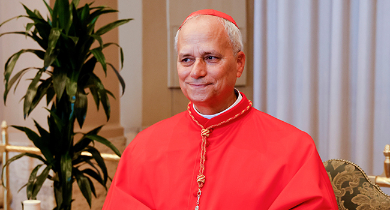
In a historic moment for the Catholic Church, Robert Francis Prevost was elected as the 267th pope on Thursday, becoming the first pontiff from the United States. Taking the papal name Leo XIV, his election was confirmed after a conclave of cardinals from across the globe reached a decision on the second day of voting.
As white smoke billowed from the chimney of the Sistine Chapel — the traditional signal of a successful papal election — the bells of St. Peter’s Basilica and churches throughout Rome rang in celebration. Tens of thousands of pilgrims and onlookers surged into St. Peter’s Square, erupting in cheers as Prevost appeared on the central balcony of the basilica, smiling warmly, bowing, and greeting the world with the words: “Peace be with you.”
The red curtains were drawn open for his first public appearance as pope, where he offered his “Urbi et Orbi” (“To the City and the World”) blessing. The new pope succeeds Pope Francis, the Argentine reformer who passed away last month at age 88 after a 12-year papacy marked by progressive reforms and efforts to foster a more inclusive Church.
A Joyful Crowd and a Global Gathering
The jubilant crowd in the square included people from all corners of the world. “It’s an amazing feeling,” said Joseph Brian, a 39-year-old chef from Belfast, Northern Ireland, who had traveled to Rome with his mother. “I’m not deeply religious, but being here among all these people just blew me away.”
There were scenes of elation as a priest waved a Brazilian flag from someone’s shoulders, while another hoisted a large crucifix in celebration. Bruna Hodara, 41, from Brazil, echoed the iconic phrase “Habemus Papam!” — “We have a pope!” — as she captured the moment on her phone. Others in the crowd waved flags and chanted “Viva il Papa!”
“It’s a once-in-a-lifetime experience,” said Florian Fried, a 15-year-old from Munich. “I’m so excited to witness history.”
An Enormous Task Ahead
Pope Leo XIV assumes the papacy at a challenging juncture for the Catholic Church. He inherits the responsibility of healing internal divisions, restoring trust in the wake of clergy abuse scandals, and providing moral guidance on a world stage fraught with conflict and uncertainty.
The conclave that elected him was the largest and most internationally diverse in history, comprising 133 cardinals from five continents. Though voting details remain confidential, the new pope had to secure a two-thirds majority. The election concluded in less than two days, consistent with recent precedent — Pope Benedict XVI was elected in four ballots in 2005, and Pope Francis in five in 2013.
Following tradition, the newly elected pope entered the “Room of Tears” after his selection, where he donned the white cassock for the first time and composed himself before returning to receive the cardinals’ pledges of obedience.
A Church at a Crossroads
The cardinals faced a profound choice: whether to continue along the path of reform or pivot toward a more traditional leadership. Francis had reshaped the Church’s priorities, focusing on issues like climate change, poverty, and migration — moves that drew praise from progressives and resistance from conservative factions.
Despite the majority of electors being appointed by Francis, the outcome was not guaranteed to reflect his ideology. The choice of Leo XIV suggests a potentially new direction, though the pope’s future actions will define his legacy.
The Church continues to face significant challenges, including waning attendance in the West, a shortage of clergy, and the need to respond to social and political upheaval worldwide. Before entering the conclave, Cardinal Dean Giovanni Battista Re urged his fellow cardinals to select someone capable of unifying the Church and providing steady leadership in a rapidly changing world.
Next Steps for the New Pope
The formal inauguration of Pope Leo XIV is expected within the week, with a public Mass attended by global dignitaries. He will likely make his first circuit of St. Peter’s Square in the popemobile before delivering a homily outlining his vision for the Church’s future.